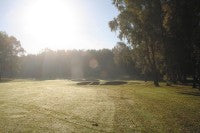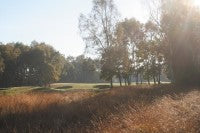The case for Biodiversity
There are golf courses that just don't gel, creating an atmosphere of tension rather than calmness. The landscape should inspire, it should offer beauty and a sense of wellbeing
 What does the next ten years hold within the golfing industry? This was the question discussed in Peter Larters (BIGGA Midland and North West) regional seminars held in the spring of 2010, and to which STRI contributed.
What does the next ten years hold within the golfing industry? This was the question discussed in Peter Larters (BIGGA Midland and North West) regional seminars held in the spring of 2010, and to which STRI contributed.
We have all seen the industry realign with the modernisation of the game and, one thing is sure, golf will continue to evolve as differing external pressures and influences bear down on it. As in nature, it is all about adaptation and the survival of the fittest. Natural selection allows those best fitted to succeed, whilst others become extinct.
In business (and each golf club is a business working independently and in competition with each other), it is essential to recognise change and adapt to it. Those that fail will struggle to survive long term. A suitable business analogy would be that a golf club is a large fish operating in a relatively small sea, and there are many other similar sized fish in the sea all competing for the same resources. As the other fish grow then the sea will effectively diminish, meaning that only the better able and better adapted will survive.
Golf clubs are working under the constraints of increasing competition, arising through the more innovative clubs moving forward as new ideas and enhanced services help provide a more rounded product offering.
Competition can manifest itself in several different guises. A major and very recent competitive pressure, on top of changing environmental legislation and developing technologies in golf, has been the global recession. This has brought with it quite severe selection pressures and is, perhaps, a first indication of the need to adapt, and adapt quickly. In nature, species that cannot adapt quickly soon become replaced by those that can. Adaptation in this sense would mean looking closely at the course and recognising areas where improvements could be made to ensure visitor and member retention.
 STRI is by no means exempt here; faced with the recession we have had to seize the opportunity to bring about new innovative solutions which, it is hoped, will bring real long term benefit to the golfing industry. Such innovation, backed by research, also enables our business to remain at the forefront of golf.
STRI is by no means exempt here; faced with the recession we have had to seize the opportunity to bring about new innovative solutions which, it is hoped, will bring real long term benefit to the golfing industry. Such innovation, backed by research, also enables our business to remain at the forefront of golf.
Take, for example, the new programme set up to allow individual golf clubs to assess the quality of the putting and playing surfaces and, for the first time, to quantitatively track the improvements being made. Such innovations are taking the guesswork and the emotion out of golf course management.
We must ask questions like: Why is it that, whilst many golf clubs are feeling the pressure of reducing visitor and member numbers, others are increasing their membership fees and maintaining good levels of recruitment?
What is it that keeps golfers returning for more? If the industry we all work in and love is based on offering a luxury commodity that, during hard times, is possible to do without, how then, does a golf club become a perceived necessity - one that golfers cannot do without, one that is just 'too good to miss'?
How does an individual golf club become 'too good to miss'?
Firstly, we must understand what it is that sets one golf club apart from the next. Does success depend upon, for example, the age of the club, its tradition, the length of the course, turf quality? It surely has to be a combination of all these factors. But, there is one overriding element here that is all too often overlooked, and that is the landscape into which the course is fitted.
The landscape can make or break a golf course - it will inspire or frustrate. There are golf courses that just don't gel, creating an atmosphere of tension rather than calmness. The landscape should inspire, it should offer beauty and a sense of wellbeing.
 We all accept that the greens are the priority, and rightly so, but we should give greater recognition to the contribution that the environment plays. We need to move away from the idea that this is a golf course and not a nature reserve, as it is both, and the environment contributes so much to retention of golfing interest.
We all accept that the greens are the priority, and rightly so, but we should give greater recognition to the contribution that the environment plays. We need to move away from the idea that this is a golf course and not a nature reserve, as it is both, and the environment contributes so much to retention of golfing interest.
Consider just how much time is spent actually connecting with the ball and playing the putting surfaces? Probably less than 10% of the round? The remaining 90% is spent walking and ideally enjoying the beauty of the surroundings. The landscape can help golfers take that short break out from the intensity of play and give them a chance to refocus and recharge for just a short lived moment, before focusing back to the reality of what lies ahead. It is, therefore, incredibly important to give time to managing these out of play areas, to get the birds singing and create that feeling of calm serenity that comes from some of the more informed and proactive golf courses.
Not convinced yet! Consider the different elements of sustainability. These are normally recognised as environmental, social and economic. These three elements make up the definition, and all are important if long-term sustainability is to be assured.
However, not all elements need assume equal importance, nor are they equally important. The environment is the basic foundation upon which social and economic sustainability can be sourced. Developing a strong social and economic infrastructure depends so much on a strong environmental foundation, and it is difficult to see the model of sustainability working any other way.
Why is biodiversity important to golf?
We all appreciate the subliminal or conscious feeling of well being that comes from a course sat within beautiful surroundings. Most golfers are not interested in naming the vast diversity of wildlife that can be found. The movement of insects, like dragonflies and butterflies, the singing of birds like the skylark and the occasional sighting of a deer, all adds up to a memorable golfing experience, and one that is worth coming back for. 'The course that is just too good to miss'.
 Of course, by developing the woodland margin by planting low growing trees, you will optimise habitat for birds, so encouraging even more. Leaving areas of longer grass will ensure a food source.
Of course, by developing the woodland margin by planting low growing trees, you will optimise habitat for birds, so encouraging even more. Leaving areas of longer grass will ensure a food source.
All businesses, including golf, depend so much on, and benefit from, biodiversity. Biodiversity is responsible for regulating the life support systems on which we all depend.
In golf, biodiversity is also important for our individual health and general well being, and those golf clubs that recognise this will be more sustainable than those that don't. Furthermore, golfers value it.
Extending the theme - How understanding biodiversity can help achieve competitive advantage
Golf clubs with good social, environmental and ethical performance will be better placed to attract and retain members and visitors.
Managing for biodiversity will maintain a clean, healthy environment, not to mention a sink for climate waste CO2 etc. Stability in the environment will bring increasing numbers of beneficial wildlife.
Recognising the benefits of biodiversity will allow golf clubs to make much more of a song and dance about how good the golf course is environmentally. This means managing it for wildlife through to carbon offsetting. We will increasingly be expected to monitor our environment, and document environmental risks and how they are managed.
Social Responsibilities
 Golf courses have a responsibility to manage in a manner that complements the local community interests. The conservation of our biodiversity is not just a job for governments and/or non-governmental organisations, it is a role for each and every individual (including golf clubs) to change our entrenched outlook and recognise the benefits, particularly on golf courses, that managing for biodiversity can bring.
Golf courses have a responsibility to manage in a manner that complements the local community interests. The conservation of our biodiversity is not just a job for governments and/or non-governmental organisations, it is a role for each and every individual (including golf clubs) to change our entrenched outlook and recognise the benefits, particularly on golf courses, that managing for biodiversity can bring.
Thinking ahead
Managing for biodiversity will improve your competitive advantage in various ways, such as in the planning arena. A golf club with a good track record will gain advantage through public approval and acceptance. Good performance, however, does need to be balanced with disclosure of performance. Those golf clubs collaborating with statutory consultees - Natural England for example - and the local authorities, should find themselves in a better position when considering course alterations, revisions etc.
It is the responsibility of every golf club to do what it can in improving its performance, as it is easy for good golf clubs to be tarred with the same brush as those not performing and failing to demonstrate ecological and environmental best practice.
The overriding message from all of the above is that golf clubs must understand the marketplace that they are working in, the aspirations that drive the sport forward and what and where added value can be generated.
Treating the environment as a luxury is no longer acceptable if golf is to survive long-term. Golf clubs must recognise the contribution of the environment, and provide an integrated and holistic way forward that will lead to long term sustainability and golf's long term stability.
STRI Innovation here to help
STRI has recently pioneered new innovation by way of the STRI Programme, a programme of data collection that allows individual clubs to benchmark putting and playing surface quality, and tailor management to bring about objective improvement. Our ecologists now use hemispherical image analysis techniques to identify and quantify inappropriate trees. This level of innovation not only maintains STRI lead in this increasingly competitive world but, for golf clubs, we are providing sophistication that will improve the quality of the greens whilst minimising tree loss, which is always an emotional problem that clubs find difficult to resolve.
If we are to move forward as motivated forward thinking golf clubs, then we first need to address the membership. Let them know the long term intention and how the golf club's competitive edge will manifest itself.
The golf club will need a business case to demonstrate the holistic or strategic intentions. This would include engaging consultants in turfgrass and ecology; it may involve an architectural assessment to ensure that, alongside the wider improvements, the golf course layout meets the criteria to ensure modern day standards are met.
The difficult task here is getting the message over in the first place but, once a plan is in place, it does become much easier to implement. A structured plan would reduce the burden on the greenstaff, it would give ownership to the issues identified at all levels within the club, all of which could be dealt with in a prioritised and structured way.
All images are of Fulford Golf in Yorkshire, where head greenkeeper, Mark Mennell, works closely with the STRI on environmental matters. ©Pitchcare/Laurence Gale MSc
